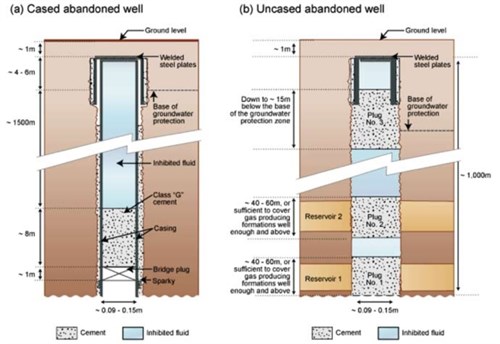As with saline aquifers, site ranking for hydrocarbon fields and coal beds is in principle based on the results of screening and storage capacityThe accumulated mass of CO2 that can be stored environmentally safely, i.e., without causing leakage of CO2 or native reservoir fluids or triggering geologic activity that has a negative impact on human health or the environment estimations that form the preliminary characterisation and storage(CO2) A process for retaining captured CO2, so that it does not reach the atmosphere safety assessment, together with the assessment of potential conflicts of use, which are not so numerous in this case (Tab. 2-10).
For the preliminary screening of hydrocarbon fields, Tab. 2-2 presented earlier is completed while for coal beds Tab. 2-3 is appropriate. Then, following the CO2QUALSTORE guidelines, the following risks have to be addressed:
- legal and regulatory (is it possible to obtain storage(CO2Carbon dioxide) A process for retaining captured CO2Carbon dioxide, so that it does not reach the atmosphereThe layer of gases surrounding the earth; the gases are mainly nitrogen (78%) and oxygen (around 21%) permit; document the screening results; avoid conflicts of use of the subsurface for other resources/applications; no conflicts with land use);
- geological and environmental (reservoirs, tectonics, hydrogeology and natural hazards are evaluated; review the industrial history of the sites considered; storage(CO2Carbon dioxide) A process for retaining captured CO2Carbon dioxide, so that it does not reach the atmosphereThe layer of gases surrounding the earth; the gases are mainly nitrogen (78%) and oxygen (around 21%) capacityThe accumulated mass of CO2Carbon dioxide that can be stored environmentally safely, i.e., without causing leakage(in CO2Carbon dioxide storage) The escape of injected fluid from the storage formationA body of rock of considerable extent with distinctive characteristics that allow geologists to map, describe, and name it to the atmosphereThe layer of gases surrounding the earth; the gases are mainly nitrogen (78%) and oxygen (around 21%) or water column of CO2Carbon dioxide or native reservoirA subsurface body of rock with sufficient porosityMeasure for the amount of pore spaceSpace between rock or sediment grains that can contain fluids in a rock and permeabilityAbility to flow or transmit fluids through a porous solid such as rock to store and transmit fluids fluids or triggering geologic activity that has a negative impact on human health or the environment and injectivityA measure of the rate at which a quantity of fluid can be injected into a well may be known sufficiently; existing Wells should be identified as they may pose possible leakage(in CO2Carbon dioxide storage) The escape of injected fluid from the storage formationA body of rock of considerable extent with distinctive characteristics that allow geologists to map, describe, and name it to the atmosphereThe layer of gases surrounding the earth; the gases are mainly nitrogen (78%) and oxygen (around 21%) or water column paths (Fig. 2-13); possible impact to vulnerable natural resources are identified including potable aquifers, protected areas).
| 
Fig. 2-13: conventional wellManmade hole drilled into the earth to produce liquids or gases, or to allow the injectionThe process of using pressure to force fluids down wells of fluids abandonment(wells) Actions taken to ensure permanent isolation of the fluids and pressures of exposed permeable zones within a wellManmade hole drilled into the earth to produce liquids or gases, or to allow the injectionThe process of using pressure to force fluids down wells of fluids from the surface and from lower pressured zones normally practised at hydrocarbon fields (IPCCIntergovernmental Panel on Climate Change, 2005). |
| Tab. 2-10: Possible conflicts of use for depleted(hydrocarbon reservoir) one where production is significantly reduced hydrocarbon fields and un-mineable coal beds (after IPCCIntergovernmental Panel on Climate Change, 2005). | Type | Hydrocarbon fields (depleted(hydrocarbon reservoir) one where production is significantly reduced/depleting) | Coal beds ("un-mineable" at present) | | Possible conflicts (with) | Gas storages | Technology developments would make coal mining for the beds in question cost efficient, underground coal gasificationProcess by which a carbon-containing solid fuel is transformed into a carbon- and hydrogen-containing gaseous fuel by reaction with air or oxygen and steam | |